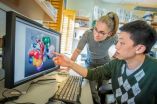(Press-News.org) (Santa Barbara, Calif. –) Bioengineering researchers at University of California, Santa Barbara have found that changing the shape of chemotherapy drug nanoparticles from spherical to rod-shaped made them up to 10,000 times more effective at specifically targeting and delivering anti-cancer drugs to breast cancer cells.
Their findings could have a game-changing impact on the effectiveness of anti-cancer therapies and reducing the side effects of chemotherapy, according to the researchers. Results of their study were published recently in Proceedings of the National Academy of Sciences.
"Conventional anti-cancer drugs accumulate in the liver, lungs and spleen instead of the cancer cell site due to inefficient interactions with the cancer cell membrane," explained Samir Mitragotri , professor of chemical engineering and Director of the Center for BioEngineering at UCSB. "We have found our strategy greatly enhances the specificity of anti-cancer drugs to cancer cells."
Changing Shape Makes Chemotherapy Drugs Better at Targeting Cancer Cells from UCSB Engineering on Vimeo.
VIDEO:
Bioengineering researchers at University of California, Santa Barbara have found that changing the shape of chemotherapy drug nanoparticles from spherical to rod-shaped made them up to 10,000 times more effective...
Click here for more information.
To engineer these high-specificity drugs, they formed rod-shaped nanoparticles from a chemotherapeutic drug, camptothecin, and coated them with an antibody called trastuzumab that is selective for certain types of cancer cells, including breast cancer. The antibody-coated camptothecin nanorods were 10,000-fold more effective than tratsuzumab alone and 10-fold more effective than camptothecin alone at inhibiting breast cancer cell growth.
"This unique approach of engineering shapes of anti-cancer drugs and combining them with antibodies represents new direction in chemotherapy," Mitragotri added.
Mitragotri and collaborators at UCSB, including post-doctoral researchers Sutapa Barua and Jin-Wook Yoo, and former graduate student Poornima Kolhar, looked to human breast cancer cells to examine how shape works in synergy with molecular recognition to perform complex tasks within the human body.
"We were inspired to look at the shape as a key parameter by natural objects. In nature, all key particles such as viruses, bacteria, red blood cells, platelets are non-spherical," said Mitragotri. "Their shape plays a key role in their function."
Their research was performed in collaboration with Yatin Gokarn and Aditya Wakankar of Genentech, a member of the Roche group. "The work of Professor Mitragotri and his collaborators exemplifies the groundbreaking contributions bioengineers at UC Santa Barbara are making in medical research, and of how our model of industry partnership delivers results," said Rod Alferness, Dean of the College of Engineering.
INFORMATION:
The study was completed with support from Genentech, the UC Discovery Program, and the Daryl and Marguerite Errett Discovery Award in Biomedical Research.
Changing shape makes chemotherapy drugs better at targeting cancer cells
Researchers at UC Santa Barbara find that making anti-cancer drug particles rod-shaped significantly increases their ability to target and inhibit breast cancer cells
2013-02-28
ELSE PRESS RELEASES FROM THIS DATE:
Retailers should re-size maternity wear for women throughout their pregnancies, MU study finds
2013-02-28
COLUMBIA, Mo. — Fashion retailers have seen an increase in demand for maternity wear in recent years, as sales for maternity clothing have increased while overall women's apparel sales have declined. Currently, most retailers produce maternity wear using a standardized size chart that begins with women in their seventh month of pregnancy. Retailers produce garments for women who are earlier in their terms by adjusting the sizes smaller proportionally based on the standardized chart. In a recent study, University of Missouri researcher MyungHee Sohn, an assistant professor ...
Reading the human genome
2013-02-28
Researchers with the U.S. Department of Energy (DOE)'s Lawrence Berkeley National Laboratory (Berkeley Lab) have achieved a major advance in understanding how genetic information is transcribed from DNA to RNA by providing the first step-by-step look at the biomolecular machinery that reads the human genome.
"We've provided a series of snapshots that shows how the genome is read one gene at a time," says biophysicist Eva Nogales who led this research. "For the genetic code to be transcribed into messenger RNA, the DNA double helix has to be opened and the strand of gene ...
Workstation design improvements for drone operators may reduce costs & mishaps, researchers suggest
2013-02-28
The U.S. Department of Defense reports that drone accidents in which personnel or aircraft are damaged or destroyed occur 50 times more often than mishaps involving human-operated aircraft. The U.S. Marines and Army reported 43 mishaps that involved human factors issues associated with drone ground control workstations and technology during 2006−2007.
Human factors/ergonomics (HF/E) researchers Qaisar Waraich, Thomas Mazzuchi, Shahram Sarkani, and David F. Rico suggest that multimillion-dollar drone losses might be prevented if long-established and broadly applied ...
Protein balance key in preventing cancer
2013-02-28
PHILADELPHIA, PA (February 27, 2013)—Two proteins that scientists once thought carried out the same functions are actually antagonists of each other, and keeping them in balance is key to preventing diseases such as cancer, according to new findings published in the February 25 issue of Developmental Cell by scientists at Fox Chase Cancer Center. The results suggest that new compounds could fight cancer by targeting the pathways responsible for maintaining the proper balance between the proteins.
"It's our job now to understand how we can intervene therapeutically in ...
NASA's Aquarius sees salty shifts
2013-02-28
The colorful images chronicle the seasonal stirrings of our salty world: Pulses of freshwater gush from the Amazon River's mouth; an invisible seam divides the salty Arabian Sea from the fresher waters of the Bay of Bengal; a large patch of freshwater appears in the eastern tropical Pacific in the winter. These and other changes in ocean salinity patterns are revealed by the first full year of surface salinity data captured by NASA's Aquarius instrument.
"With a bit more than a year of data, we are seeing some surprising patterns, especially in the tropics," said Aquarius ...
GSA Today: Putting time in its place
2013-02-28
Boulder, Colorado, USA – In the March issue of GSA Today, seven scientists from six countries, led by Jan Zalasiewicz of the University of Leicester, propose a realignment of the terms "geochronology" and "chronostratigraphy" in an attempt to resolve the debate of whether units of the Geological Time Scale should have a single (time) or dual (time and time-rock) hierarchy.
In their system, which retains both parallel sets of units, with an option to adopt one or other when appropriate, geochronology refers to all methods of numerical dating and is used to express the ...
Fermi's motion produces a study in spirograph
2013-02-28
VIDEO:
The Vela pulsar outlines a fascinating pattern in this movie showing 51 months of position and exposure data from Fermi's Large Area Telescope (LAT). The pattern reflects numerous motions of...
Click here for more information.
NASA's Fermi Gamma-ray Space Telescope orbits our planet every 95 minutes, building up increasingly deeper views of the universe with every circuit. Its wide-eyed Large Area Telescope (LAT) sweeps across the entire sky every three hours, capturing ...
Rapid, point-of-care tests for syphilis: The future of diagnosis
2013-02-28
Montreal, February 27th – Syphilis is on the rise worldwide and there is an urgent need for reliable and rapid screening, particularly for people who live in areas where access to healthcare is limited. An international research team, led by scientists at the Research Institute of the McGill University Health Centre (RI-MUHC) in Montreal, has demonstrated that rapid and point-of-care tests (POC) for syphilis are as accurate as conventional laboratory tests. The findings, which were published in PLoS ONE, call for a major change in approach to syphilis testing and recommend ...
Reading, writing, arithmetic, and aerobics -- Evaluating the new 'R' in academic performance
2013-02-28
Cincinnati, OH, February 28, 2013 -- Although the long-term consequences of childhood obesity are well documented, some school districts have reduced physical education classes to devote more time to the 3 Rs in education—reading, writing, and arithmetic. However, there is new evidence that leaving out an important fourth R—aerobics—could actually be counterproductive for increasing test scores. A new study scheduled for publication in The Journal of Pediatrics studied the associations between aerobic fitness, body mass index (BMI), and passing scores on standardized ...
Helping dementia patients remember to eat well improves physical and mental health
2013-02-28
A new analysis has found that a combination of methods that help patients with dementia remember proper eating habits can improve their physical health and lessen symptoms of depression. Published early online in the Journal of Advanced Nursing, the study indicates that clinicians should consider using this intervention in individuals with dementia who also have poor nutrition and signs of depression.
In patients with dementia, poor nutrition or decreased food intake may cause symptoms of depression. Investigators including Li-Chan Lin, RN, PhD, of the National Yang-Ming ...
LAST 30 PRESS RELEASES:
Ticking time bomb: Some farmers report as many as 70 tick encounters over a 6-month period
Turning garden and crop waste into plastics
Scientists discover ‘platypus galaxies’ in the early universe
Seeing thyroid cancer in a new light: when AI meets label-free imaging in the operating room
Neutrophil-to-lymphocyte ratio may aid risk stratification in depressive disorder
2026 Seismological Society of America Annual Meeting
AI-powered ECG analysis offers promising path for early detection of chronic obstructive pulmonary disease, says Mount Sinai researchers
GIMM uncovers flaws in lab-grown heart cells and paves the way for improved treatments
Cracking the evolutionary code of sleep
Medications could help the aging brain cope with surgery, memory impairment
Back pain linked to worse sleep years later in men over 65, according to study
CDC urges ‘shared decision-making’ on some childhood vaccines; many unclear about what that means
New research finds that an ‘equal treatment’ approach to economic opportunity advertising can backfire
Researchers create shape-shifting, self-navigating microparticles
Science army mobilizes to map US soil microbiome
Researchers develop new tools to turn grain crops into biosensors
Do supervised consumption sites bring increased crime? Study suggests that’s a myth
New mass spec innovation could transform research
Maternal nativity, race, and ethnicity and infant mortality in the US
Migration-related trauma among asylum seekers exposed to the migrant protection protocols
Jupiter’s moon Europa has a seafloor that may be quiet and lifeless
SwRI upgrades nuclear magnetic resonance laboratory for pharmaceutical R&D
House sparrows in northern Norway can help us save other endangered animals
Crohn's & Colitis Foundation survey reveals more than 1/3 of young adults with IBD face step therapy insurance barriers
Tethered UAV autonomous knotting on environmental structures for transport
Decentralized social media platforms unlock authentic consumer feedback
American Pediatric Society announces Vanderbilt University School of Medicine as host institution for APS Howland Visiting Professor Program
Scientists discover first method to safely back up quantum information
A role for orange pigments in birds and human redheads
Pathways to net-zero greenhouse gas emissions for Southeast Asia
[Press-News.org] Changing shape makes chemotherapy drugs better at targeting cancer cellsResearchers at UC Santa Barbara find that making anti-cancer drug particles rod-shaped significantly increases their ability to target and inhibit breast cancer cells




